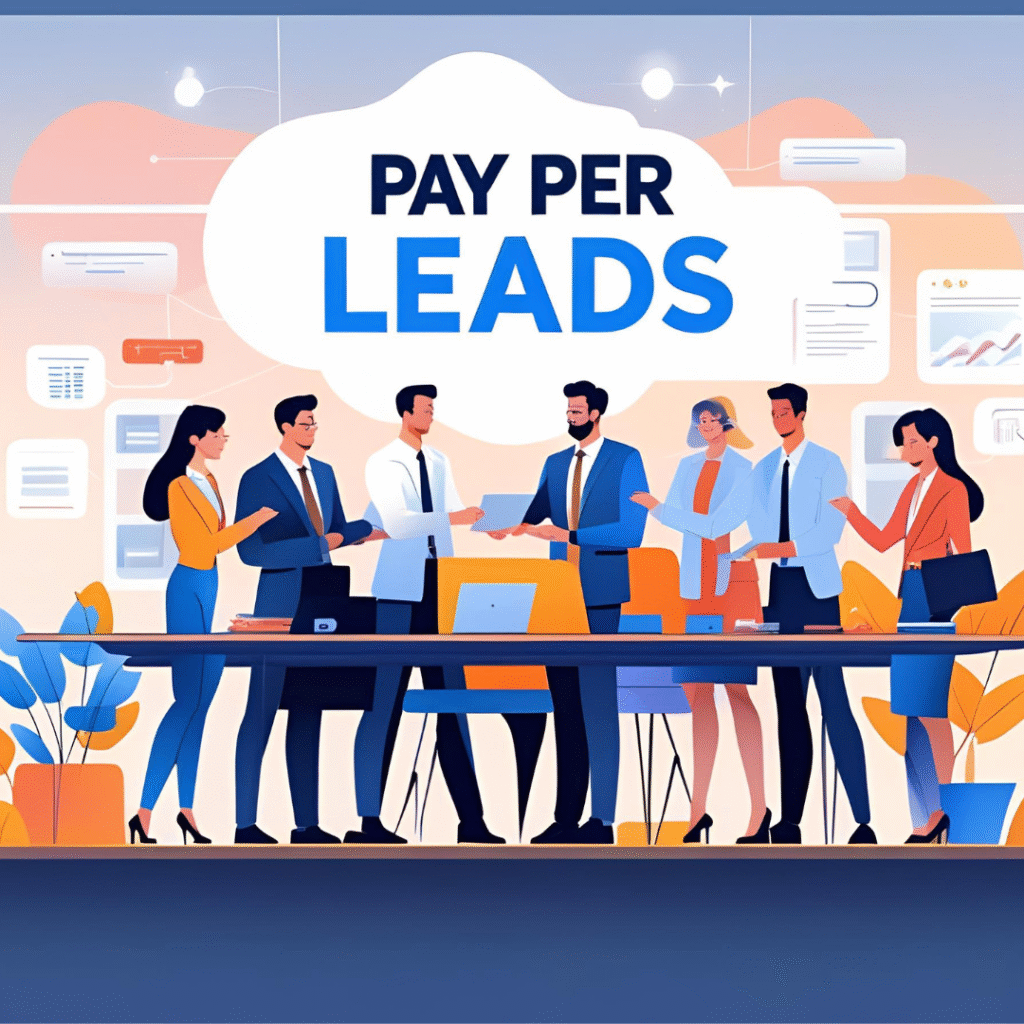Have you ever wondered how businesses find new customers? It’s a big question! One smart way is called Pay Per Leads. or PPL. Imagine only paying when someone is truly interested in what you sell. That’s PPL! It’s like a special deal for businesses. They get to meet people who might buy their stuff. And they don’t pay until that meeting happens. This helps them grow without spending too much money at first. PPL is becoming very popular. It’s because it helps businesses save money. They also get good results. This article will explain all about PPL. We’ll see how it works. We’ll also see why it’s good for many businesses. You’ll learn the secrets of getting more customers. And you’ll learn how to do it safely.
What is Pay Per Leads and How Does It Work?
Pay Per Leads is a simple idea. A business pays only for qualified leads. A lead is someone who shows interest. For example. a car dealership wants to sell cars. They could use PPL. They pay a marketing company. The company finds people who want to buy a car. When someone fills out a form saying they want a car. that’s a lead. The dealership then pays for that specific lead. They don’t pay for ads that no one clicks. They don’t pay for people who aren’t interested. This makes PPL very efficient. It saves money and time. It focuses on results. This is a big difference from old advertising methods. Old ways cost money upfront. You hoped people would notice. With PPL. you pay for real interest.
The Benefits: Why Businesses Love PPL
PPL has big plus points. Firstly. it reduces risks. Businesses don’t spend money hoping for results. They only invest when real leads appear. This makes budgeting much clearer. It’s like buying guaranteed appointments. Furthermore. PPL often delivers better quality leads. Marketers work hard to filter out poor prospects. They use advanced targeting methods. This means businesses talk to genuinely interested people. Imagine fewer wasted sales calls! Consequently. conversion rates can improve dramatically. More leads turn into actual customers.
Another key benefit is clear return on investment (ROI). Businesses can easily track their spending. They can see exactly how many customers came from PPL. This clear data helps them make smart choices. They can put more money into what works. Also. PPL saves time. Businesses don’t need to create ads. They don’t need to manage complex campaigns. They just receive ready-to-contact leads. This frees up their team. They can focus on what they do best. That’s selling and serving customers. Ultimately. PPL helps businesses grow faster. It’s a powerful tool for customer acquisition.
Who Uses Pay Per Leads?
Many different businesses use PPL. Service industries especially benefit. Think about insurance companies. They need people interested in latest mailing database policies. Financial advisors also use PPL. They seek clients for investments. Home improvement companies find it useful. They want homeowners ready for renovations. Lawyers often use PPL too. They look for new cases. Education providers use it for students. Healthcare providers seek new patients. Even B2B (business-to-business) companies use it. They find other businesses to partner with.
Small businesses can benefit greatly. They may not have big marketing budgets. PPL lets them compete. They get serious leads without huge upfront costs. Large corporations also use PPL. It helps them scale their efforts. They can reach many more potential customers. In short. almost any business that needs new customers can use PPL. It’s a versatile strategy. It adapts to different industries. It works for various business sizes.

How Leads Are Generated
So. how do these leads appear? Lead generation is an art. It involves many methods. Often. it starts with online advertising. This includes search engine ads. People search for something. Then they see an ad. Social media ads are also common. These appear on Facebook. Instagram. etc. Content marketing plays a role. This means creating helpful articles or videos. These draw in interested people. Email marketing can also generate leads. Businesses send offers to their lists.
Affiliate marketing is another way. Other websites promote your business. They get paid for leads. Lead generation companies specialize in this. They have their own methods. They use landing pages. These are special webpages. People fill out forms there. They ask for information. They express interest. These companies also use call centers. They connect with potential customers directly. The key is finding people actively looking. They are looking for the service or product. This ensures higher quality leads. Therefore. the methods are diverse. They all aim for genuine interest.
Setting Up a Successful Pay Per Leads Campaign
Getting PPL right needs careful planning. First. define your ideal customer. Who do you want to reach? What problems do they have? What mobile optimization for lead generation success do they need? Knowing this helps find the best leads. Next. set a clear budget. How much can you pay per lead? This affects the campaign’s scale. It also determines lead quality. Think about your average customer value. How much profit do they bring? This helps decide your spending.
Furthermore. choose the right lead generation partner. Look for experienced companies. Check their reputation. Ask for case studies. Do they understand your industry? A good partner is crucial. They will help you succeed. Discuss lead quality upfront. Agree on what makes a “qualified” lead. This avoids misunderstandings later. Finally. be ready to follow up. Leads need quick attention. Don’t let them go cold. Have a sales process in place. This will turn leads into customers. A strong follow-up makes all the difference.
Measuring Success
How do you know if PPL works? You need to measure it! The main goal is usually conversions. How many leads become paying customers? This is the ultimate test. Track your cost per lead (CPL). This shows what each lead costs you. Compare it to your customer value. Is it a good return? Also. monitor the quality of leads. Are they good matches for your business? Are they easy to close? Sometimes a cheaper lead isn’t better. If they don’t buy. they’re not useful.
Another important metric is sales cycle length. How long does it take? From lead to customer? Faster is usually better. Track your ROI (return on investment). This is how much money you make back. Compare it to what you spent. A positive ROI means success. Regularly review these numbers. Make changes if needed. Adjust your strategy. This data-driven approach is vital. It helps you improve over time. Measurement ensures continued success.
Common Challenges
PPL isn’t always perfect. There are some hurdles. One challenge is lead quality. Sometimes. leads might not be truly interested. They might just be curious. This can waste time and effort. It’s important to set clear lead definitions. Another issue can be lead quantity. Some days you might get many leads. Other days. very few. This can make planning hard. It requires flexibility.
Also. competition can be tough. Many businesses want the best leads. This can drive up prices. You might pay more per lead. Furthermore. there’s a risk of fraud. Some bad actors might send fake leads. It’s rare. but it happens. Choose reputable partners carefully. Finally. integration can be tricky. How do leads get to your sales team? Make sure the process is smooth. Good communication is key. Despite challenges. careful planning helps. Most issues can be overcome. PPL remains a strong strategy.
The Future of Pay Per Leads
PPL is always changing. Technology plays a big role. Artificial Intelligence (AI) is making a difference. AI can analyze data. It can find the best leads. It can predict who will buy. This makes lead generation smarter. Machine learning helps too. It learns from past results. It improves lead targeting. This means even higher quality leads. This will make PPL even more efficient.
Personalization is also growing. Leads will get tailored messages. They will see offers just for them. This increases their interest. It boosts conversion rates. Voice search is another trend. People use smart speakers. They ask for services. PPL will adapt to this. Businesses will need to be found via voice. Furthermore. data privacy is becoming more important. New rules are coming. Lead generation companies must follow them. This builds trust. It protects consumer information. The future of PPL looks promising.
Is Pay Per Leads Right for Your Business?
Deciding if PPL is for you depends on a few things. First. consider your sales cycle. Do you sell high-value products? Or do you have complex services? PPL works well here. It gives you warm leads to nurture. Second. think about your marketing budget. If you have limited funds. PPL is low risk. You only pay for what you get. Third. do you have a strong sales team? They must be ready to act fast. Leads go cold quickly.
If you answered yes to these. PPL might be a good fit. It’s an excellent way to scale. It helps businesses avoid wasted ad spend. However. if hong kong data your business relies on quick. impulse buys. it might be less useful. Or if you lack sales follow-up. it won’t be effective. Consider your specific needs carefully. Talk to a PPL expert. They can help assess your situation. Pay Per Leads offers a powerful path to growth. It’s about smart spending. It’s about getting real results.

